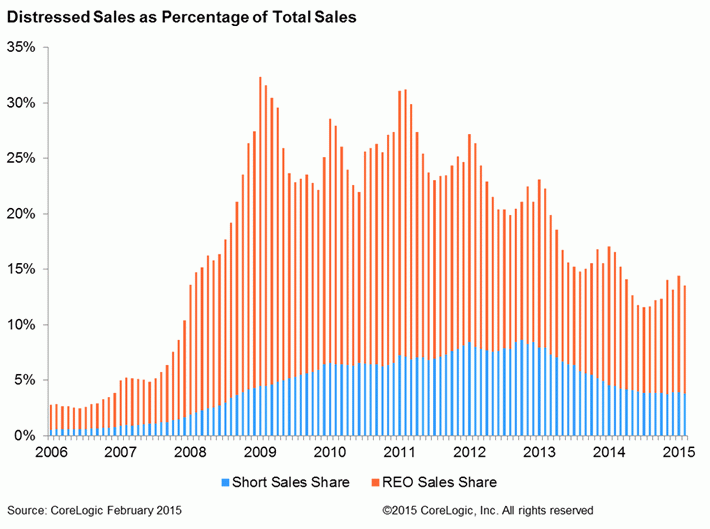While CoreLogic says February is typically a month in which distressed sales post a seasonal decline, real-estate owned (REO) and short sales this past February were the lowest for that month since 2008. Combined they accounted for 13.5 percent of total sales, down 0.8 of a point from January and a 3 percentage point drop from February 2014.

REO sales accounted for 9.7 percent of all sales during the month and short sales for 3.8 percent. Distressed sales are now at one-third the level there were in January 2009 when those sales peaked at 32.4 percent of all sales. At that point REO accounted for 27.9 percent of sales.
The company says the share of distressed sales before the housing crisis was traditionally about 2 percent. While there will always been some level of distress in the housing market CoreLogic projects that, at the current rate of year-over-year decline, distressed sales should return to that "normal" 2 percent level in mid-2017. The decline in REO sales is one driver of rising prices as those properties usually sell at a larger discount than short sales.
Distressed sales are still elevated in many states. Michigan had the largest share in February at 22.6 percent closely followed by Florida at 22.2 percent. Other states that were well above the national average were Illinois (20.4 percent), Maryland (19.1 percent) and Connecticut (19 percent).
The largest decline in the percentage of distressed homes was in Nevada with an annual drop of 8.4 percentage point. California had the largest improvement of any state from its peak distressed sales share, falling 57.3 percentage points from its January 2009 peak of 67.5 percent.
Of the largest 25 Core Based Statistical Areas (CBSAs) by number of mortgage loans, Miami-Miami Beach had the largest share of distressed sales at 24.4 percent, followed by Orlando (24.4 percent), Tampa-St. Petersburg-Clearwater (23.8 percent), Chicago (23.1 percent) and Las Vegas-Henderson-Paradise (19.1 percent). At the peak in February 2009 distressed sales made up 76.3 percent of sales in the Riverside-San Bernardino-Ontario CBSA. That share had dropped to 13.2 percent in February 2015. The largest change over the 12 months ended this February was in Atlanta where distressed sales fell by 9.2 percentage points to 16.2 percent of sales.







